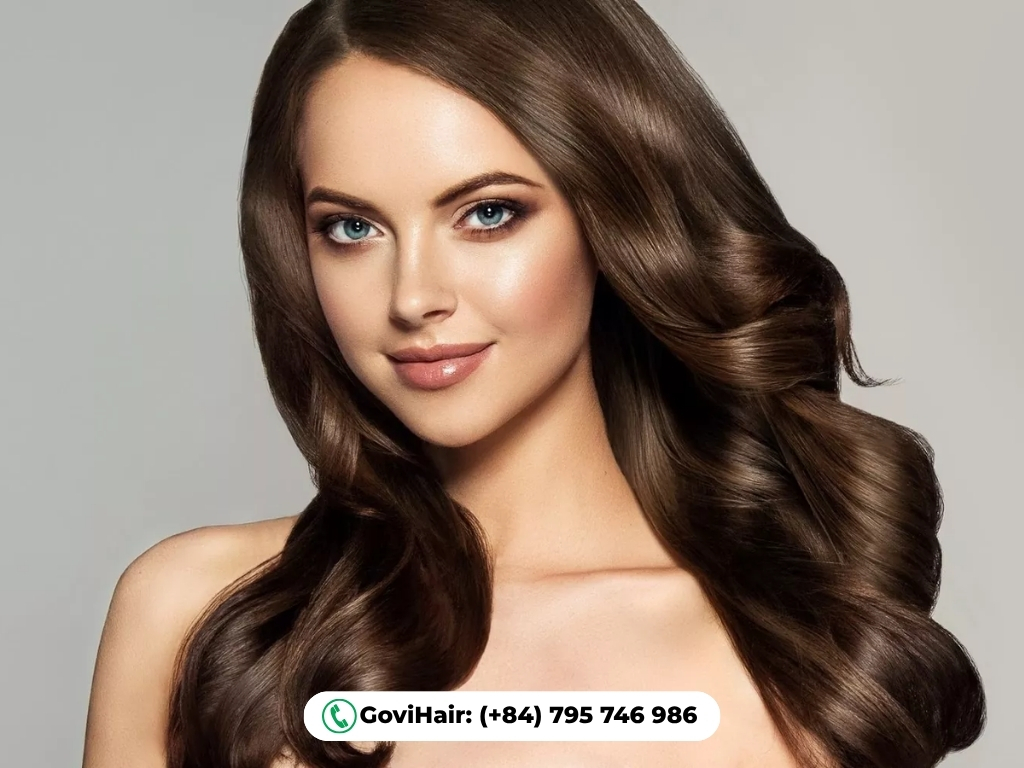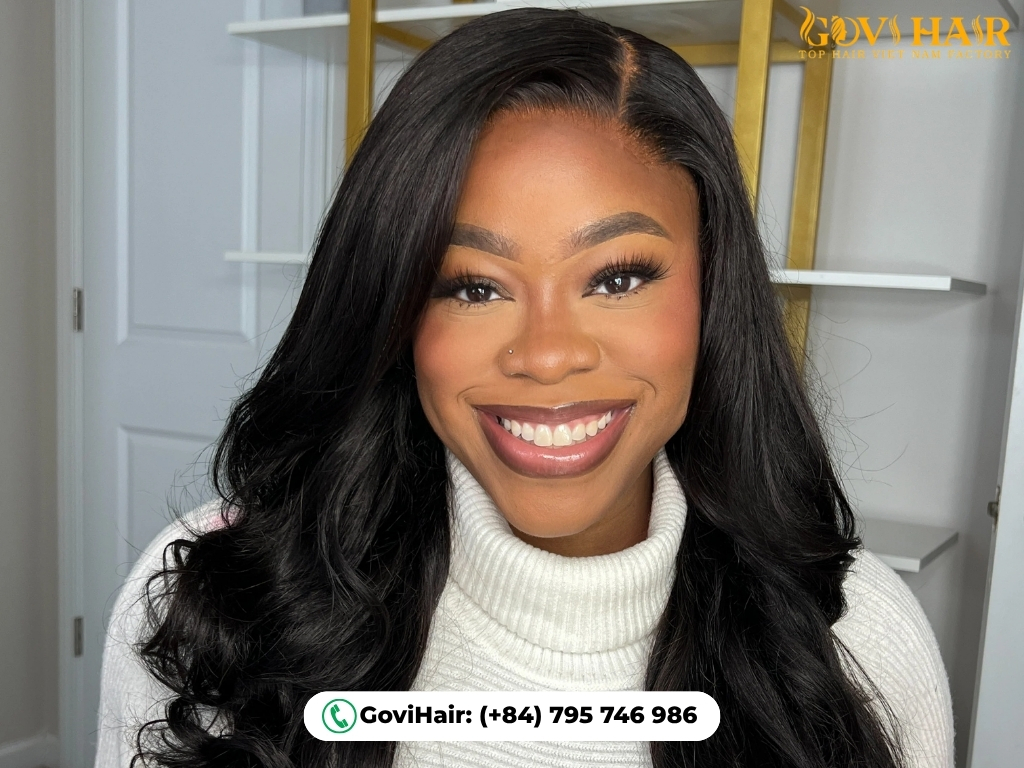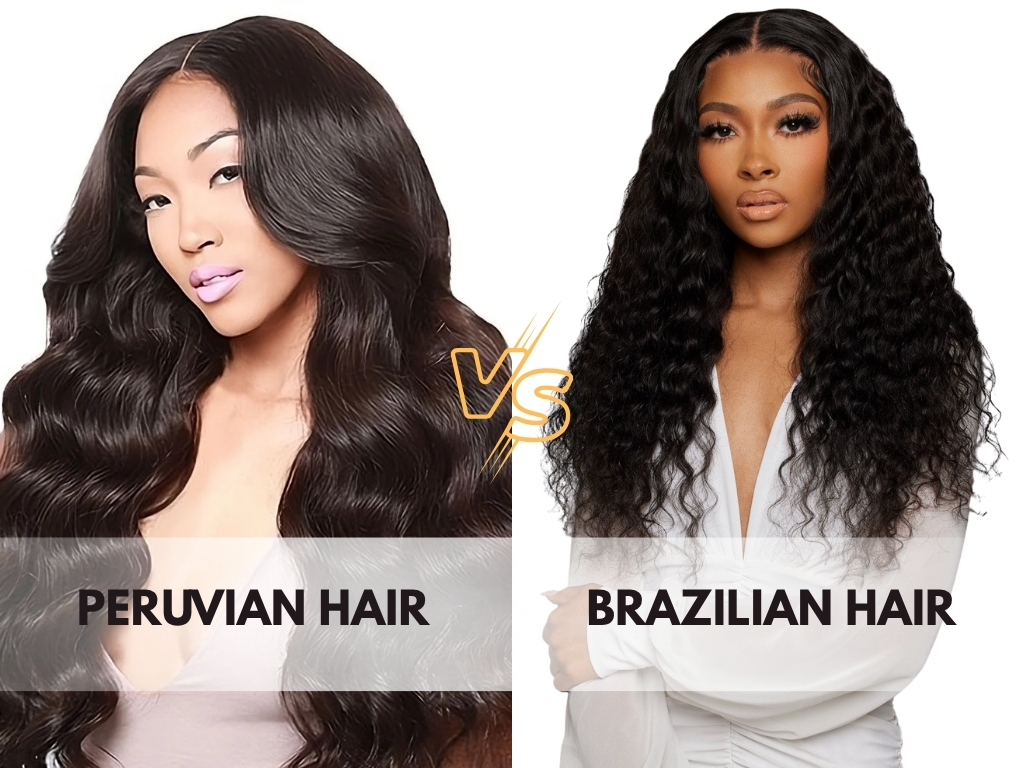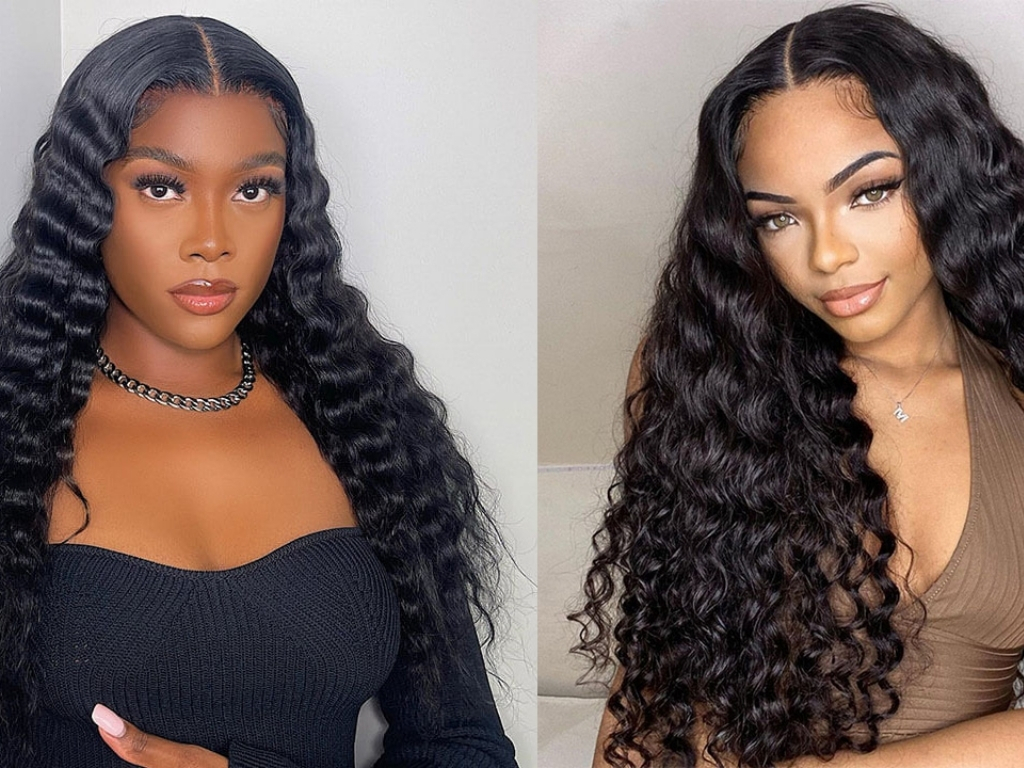When choosing hair for business or personal use, customers often compare Peruvian Hair and Brazilian Hair. Both are well-known and popular hair types on the international market, but understanding the difference between brazilian and peruvian hair is key to finding the perfect match for your style and needs. This blog from Govihair will provide a detailed comparison of peruvian hair vs brazilian hair to help you make the most informed decision.
What Is Brazilian Hair? Is Brazilian Hair Good?
Brazilian Hair originates from Brazil. Virgin Brazilian hair is renowned for its quality, thickness, durability, and natural shine. Its texture is typically thick, strong, and has a low to medium luster
Key features:
- Thicker and stronger strands compared to Peruvian Hair, giving a luxurious appearance
- Holds curls very well
- Suitable for customers who want fuller, thicker-looking hair
- Durability: 2–4 years with proper care
“Is Brazilian hair good?” – The answer is a resounding yes. It is considered one of the most versatile and high-quality hair types, blending well with almost all natural hair textures.

What Are the Benefits of Brazilian Hair?
- Thickness and Density: Brazilian hair is very thick and dense, helping to create maximum volume and body. You often need fewer bundles to achieve a full look.
- Luster: It has a natural, healthy shine without looking overly glossy or synthetic.
- Excellent Curl Retention: This is one of its biggest advantages. Brazilian hair holds curls exceptionally well, even after washing.
- Durable: With its strong hair shaft, Brazilian hair is very durable and can last a long time with proper care.
How to Take Care of Brazilian Hair Properly
To maintain the beauty of your Brazilian hair, you need to care for it as you would your own natural hair:
- Wash Correctly: Use sulfate-free shampoo and conditioner to retain natural moisture.
- Moisture is Key: Because the hair is thick, it needs regular moisturizing with a light oil or serum.
- Limit High Heat: Although Brazilian hair is heat-resistant, overuse of heat styling tools can damage the hair.
- Detangle Gently: Use a wide-tooth comb to detangle, starting from the ends and working your way up to the roots.
>>Explore more: Body Wave Vs Deep Wave: What Are The Differences?
What Is Peruvian Hair?
Peruvian Hair comes from Peru and is known for being lightweight, soft, and naturally textured. It feels very comfortable when worn and gives the hair a fuller look while still appearing natural.
Key features:
- Softer and lighter than Brazilian Hair, creating natural volume
- Easy to style
- Ideal for customers who prefer a natural, comfortable, lightweight feel
- Durability: 1–3 years depending on care
Compared to Brazilian hair, Peruvian hair generally feels lighter but still offers medium density. It provides a natural, bouncy flow and blends perfectly with many hair textures, especially thin or medium hair.

What Are the Benefits of Peruvian Hair?
- Super Lightweight: This is its most prominent feature. You can use multiple bundles of Peruvian hair without feeling weighed down.
- Soft & Silky: Peruvian hair has a luxurious feel and is incredibly soft to the touch.
- Versatile: It can be easily styled straight, curly, or wavy. Despite being lightweight, it is still thick enough to create a full, voluminous style.
- Blends Well: It is ideal for those with thin to medium hair, creating a fuller look that remains very natural.
How to Maintain the Health of Your Peruvian Hair
- Be Gentle When Combing: Because the hair is soft and light, always be gentle to avoid breakage.
- Use Sulfate-Free Products: Like Brazilian hair, this helps protect the hair cuticles.
- Avoid Heavy Products: Don’t overuse heavy oils or styling products, as they can weigh the hair down and make it look greasy, losing its natural bounce.
- Protect at Night: Tie your hair loosely or use a silk bonnet when sleeping to reduce friction.
The Similarities Between Brazilian and Peruvian Hair
While the peruvian hair vs brazilian hair debate often focuses on what makes them different, it’s crucial to recognize that they share many significant qualities. Both are considered top-tier options in the premium hair market for the following reasons:
100% Virgin Human Hair
The most important similarity is that both are 100% brazilian vs peruvian human hair when sourced correctly. This means:
- Single Donor: The hair is collected from a single donor.
- Chemically Unprocessed: The hair is completely “virgin,” meaning it has not been bleached, dyed, permed, or chemically treated.
- Cuticle Intact: All cuticles are intact and aligned in the same direction. This is what makes the hair soft, smooth, tangle-free, and long-lasting.

Versatility and Stylability
Both Brazilian and Peruvian hair are extremely versatile. They both:
- Hold Curls Well: Both hair types can hold a curl (from a curling iron or rollers) beautifully.
- Handle Heat: You can safely blow-dry, flat-iron, or curl the hair without damage (as long as a heat protectant is used).
- Take Color Well: As virgin hair, both types can be easily dyed or bleached to lighter shades.
Natural Color and Luster
Both hair types come in natural colors, typically ranging from natural black (1B) to dark brown. They possess a healthy, natural luster that isn’t overly shiny or synthetic-looking.
South American Origin
Both types of hair originate from South America. While from different countries, similar genetic and environmental factors contribute to their comparable high quality and healthy hair strands.
>>Read more: 7 Best Closure Sew In Hairstyles Trending For Flawless Looks
The Differences Between Brazilian and Peruvian Hair
While they share many premium qualities, the subtle differences are the key factors in the peruvian hair vs brazilian hair comparison. Understanding what is the difference between brazilian and peruvian hair will help you decide which hair type best suits your desired style and needs.
Peruvian Hair vs Brazilian Hair Textures
This is the largest and most noticeable difference between brazilian and peruvian hair.
- Brazilian Hair: Brazilian Hair offers a fuller, shinier, and stronger look. It holds styles—especially curls—better. This type of hair is ideal for customers who want high density or a glamorous, voluminous hairstyle.
- Peruvian Hair: Peruvian Hair feels light, soft, and naturally voluminous, making it perfect for those who prefer a natural and comfortable look. The strands range from thin to medium thickness, making it comfortable for long-term wear.
This core difference in texture is perfectly illustrated by the peruvian body wave vs brazilian body wave styles. Because Brazilian hair is heavier, its body wave pattern is deeper, more defined, and very full. In contrast, the Peruvian body wave is lighter and softer, creating a more subtle, airy wave with a lot of natural movement.

Brazilian vs Peruvian Hair Color
Both types of virgin hair come in natural colors, typically natural black (1B) or dark brown. The difference isn’t in the original color, but in how they take to color processing. Because Peruvian hair has a finer, softer texture, some users find it slightly easier to bleach and dye to very light tones (like 613 blonde) compared to the often thicker, denser Brazilian hair.
Brazilian vs Peruvian Hair Price
This is a very common question: is peruvian hair more expensive than brazilian hair?
Typically, the answer is yes. Peruvian hair often carries a slightly higher price tag. This is because Peruvian hair is considered rarer, and its highly sought-after silky, lightweight texture is in high demand. Brazilian hair, being more common in the market, is usually slightly more competitively priced.
Peruvian vs Brazilian Hair Length
In terms of available length, there is no significant difference. Both brazilian vs peruvian hair are readily available in a wide range of lengths, from 8 inches (short) to 30 inches (very long) or more.
However, a point to consider related to texture: because Peruvian hair is so lightweight, you may need more bundles (4-5 bundles) to achieve the same level of fullness as Brazilian hair (3-4 bundles) when choosing very long lengths (24 inches and up).
Brazilian vs Peruvian Hair Durability
Both are extremely durable hair types. However, if we must make a direct comparison, Brazilian hair is often considered slightly more durable. Due to its thicker, stronger strands, it can withstand heat styling and repeated chemical processing exceptionally well.
Peruvian hair, being finer and softer, may require slightly more gentle care to maintain its longevity. That said, with proper maintenance, both hair types can easily last for over a year.
Brazilian vs Peruvian Hair: Which One Should You Choose?
Many people wonder, is peruvian better than brazilian hair?The answer depends on your goals and your natural hair type. There is no absolute “best” answer.
Choose Brazilian Hair if:
- You want hair with maximum volume and thickness.
- Your natural hair is thick, and you need extensions that will blend well.
- You prefer defined curls that hold their shape for a long time.
- You don’t mind a slightly heavier feel.
Choose Peruvian Hair if:
- You want a lightweight, bouncy, and airy feel.
- Your natural hair is thin or has a medium thickness.
- You prefer a soft, silky, and natural look.
- You need multiple bundles for length but don’t want to feel weighed down.
In summary, what type of hair is better brazilian or peruvian is a personal choice based on style.Choose Peruvian Hair if you prefer lightweight, soft, natural-looking hair that you can wear comfortably every day and choose Brazilian Hair if you want thick, strong, shiny hair that holds curls well and gives a fuller, more luxurious look.

>>See more: Loose Wave Vs Deep Wave: What’s Difference?
Where to Buy Brazilian & Peruvian Hair Wigs and Bundles?
Once you’ve decided which hair type is right for you, the most important step is finding a reputable supplier. A high-quality virgin hair vendor will ensure you receive 100% real, unprocessed human hair.
While Brazilian & Peruvian Hair are popular options, many users are searching for a solution that combines the best features of both. At Govihair, we offer a premium alternative that salon experts and connoisseurs worldwide are increasingly turning to: Natural Vietnamese Hair which offers the ‘best of both worlds’. It provides the thick density, fullness, and durability often associated with Brazilian hair, while simultaneously maintaining the natural softness and silky luster found in Peruvian hair (without being overly fine or lightweight). Most importantly, Natural Vietnamese Hair is globally renowned for its superior longevity, widely considered one of the most durable hair types on the market.
Whether you’re looking to add volume, cover thinning areas, or simply get creative, GoviHair gives you salon-grade hair at factory-direct prices.
With fast global shipping and flexible customization options, it’s easy to find the right curly base that blends naturally and wears comfortably all day.
>> Discover GoviHair’s Premium Collections
Chat With Us:
- WhatsApp: (+84)795 746 986
- Email: [email protected]
- Instagram: gov hair vietnam factory
- Tik Tok: govihairvietnam_official
- Website: https://govihair.com/

FAQs About Peruvian Hair And Brazilian Hair
Which is softer, Peruvian or Brazilian hair?
Peruvian hair is generally considered softer. It’s renowned for its super-lightweight, fine, and silky-smooth texture. While Brazilian hair is also soft, it is much thicker and slightly coarser by comparison.
Does Peruvian or Brazilian hair hold curls better?
Brazilian hair holds curls significantly better. Its high density, weight, and stronger texture allow it to “grip” a curl pattern and maintain it for a very long time. Peruvian hair is often too soft and light, causing curls to loosen more quickly.
Which is better for fine or thin hair, Peruvian or Brazilian?
Peruvian hair is the clear winner for fine or thin hair. Because it’s extremely lightweight, it won’t weigh down or strain your natural hair. It blends seamlessly to add volume without looking bulky.
Is Peruvian hair or Brazilian hair thicker and more voluminous?
Brazilian hair is significantly thicker and provides more volume. The primary benefit of Brazilian hair is its high density, allowing you to achieve a “big,” full look with fewer bundles.
What are the main pros and cons of Peruvian vs Brazilian hair?
Peruvian hair’s main advantages are that it is extremely soft, lightweight, and creates a very natural, comfortable volume. Its main drawback is that it doesn’t hold curls as well and is not as thick as Brazilian hair.
Brazilian Hair Brazilian hair stands out for being very thick, strong, and holding curls exceptionally well for a long time. Its only significant con is that this density makes it feel noticeably heavier on the head than Peruvian hair.
Conclusion
In conclusion, the peruvian hair vs brazilian hair showdown has no absolute winner. Both are luxurious, high-quality options. Brazilian hair offers unparalleled thickness and curl retention, while Peruvian hair wins users over with its softness, light weight, and bouncy flow.
Understanding the difference between brazilian and peruvian hair is the first step to finding the perfect companion for your hair. We hope this detailed comparison has helped you make the best choice for you.









 Ms. Victoria
Ms. Victoria